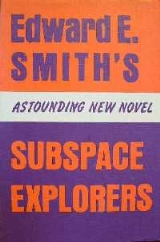
Subspace Explorers
Encyclopedia
Subspace Explorers is a science fiction novel by E. E. "Doc" Smith
. It was first published in 1965
by Canaveral Press
in an edition of 1,460 copies. The novel is an expansion of Smith's story "Subspace Survivors" which first appeared in the July 1960 issue of the magazine Astounding.
is a philosophy that has existed for hundreds of years.
In the course of the book, Doc Smith extends this principle into an economic formula used for calculating profits and bonuses. After describing a deadly planet-wide strike, he discusses the ensuing development of this economic principle.
Later, he says:
E. E. Smith
Edward Elmer Smith, Ph.D., also, E. E. Smith, E. E. "Doc" Smith, Doc Smith, "Skylark" Smith, and Ted was a food engineer and early science fiction author who wrote the Lensman series and the Skylark series, among others...
. It was first published in 1965
1965 in literature
The year 1965 in literature involved some significant events and new books.-New books:*Lloyd Alexander - The Black Cauldron*J. G. Ballard - The Drought*Ray Bradbury - The Vintage Bradbury*John Brunner...
by Canaveral Press
Canaveral Press
Canaveral Press was a New York-based publisher of fantasy, science fiction and related material, active from the early 1960s through the mid-1970s. Richard A...
in an edition of 1,460 copies. The novel is an expansion of Smith's story "Subspace Survivors" which first appeared in the July 1960 issue of the magazine Astounding.
Plot introduction
It is essentially in three overlapping parts:- A space catastrophe and its results
- The discovery and scientific study of psionics
- A war between the corrupt and shortsighted (including Labour, politicians, Soviet-style communists and greedy capitalists) and those who can see a bit further (mostly tradesmen, professionals, and businessmen).
The principle of enlightened self-interest
The principle of enlightened self-interestEnlightened self-interest
Enlightened self-interest is a philosophy in ethics which states that persons who act to further the interests of others , ultimately serve their own self-interest....
is a philosophy that has existed for hundreds of years.
In the course of the book, Doc Smith extends this principle into an economic formula used for calculating profits and bonuses. After describing a deadly planet-wide strike, he discusses the ensuing development of this economic principle.
- Capital must make enough profit to attract investors, and wants to make as much more than that minimum as it can. Labor must make a living, and wants as much more than that minimum as it can get. Between those two minima lies the line of dispute, which is the locus of all points of reasonable and practicable settlement. Somewhere on that line lies a point, which can be computed from the Law of Diminishing Returns as base, at which Capital's net profit, Labor's net annual income, and the public's benefit, will all three combine to produce the maximum summated good.
Later, he says:
- Every employee, from top to bottom, received an annual basic salary plus a bonus. This bonus varied with the net profit of the firm, and each employee's actual ability.

